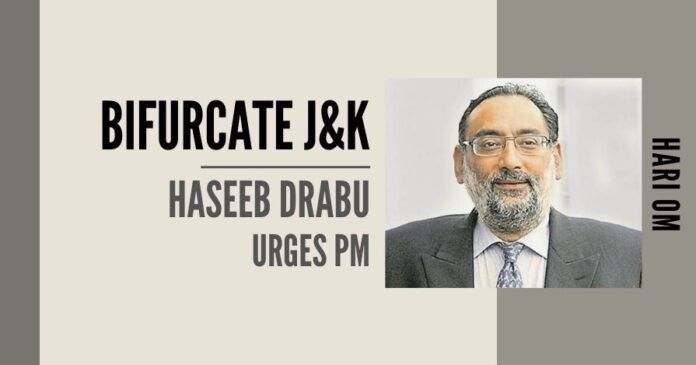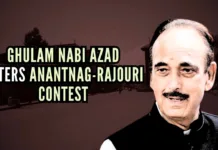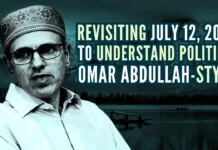
Bifurcation of the UT of J&K is an exigency of the time and need of the nation
Politics in jihad-gripped Kashmir is undergoing a change. Many in the state, barring vested interests, have virtually acknowledged that no power on earth will ever be in a position to restore the status J&K enjoyed before August 5, 2019, and that they have to accept the reality that New Delhi is now controlled by a political class that is all out to undo the grave wrongs J Nehru and ilk committed in J&K and created a serious problem for the nation in this region whose borders touch the hostile China and Pakistan.
Take, for example, former Finance Minister in the PDP-led coalition government and one of the chief architects of the 2015 “divisive” BJP-PDP agenda of alliance, Haseeb Drabu, who and whose relations, along with thousands of others, have been accused of looting state land under the obnoxious Roshni Act of Farooq Abdullah, which was also amended by Mufti Sayeed and Ghulam Nabi Azad, to further allow loot and plunder of state and other prime lands, mostly in Jammu’s Sunjuwan, Bathindi, Bahu area, Sidhra, Nagrota and along River Tawi, also called Surya Putri. Haseeb Drabu has started making the right political noises appreciating the changed all-powerful South and North Blocks. So much so, he has gone to the extent of urging the Narendra Modi government to amend the 2019 J&K Reorganization Act and divide the leftover J&K into two states, if possible or create two UTs out of the UT of J&K – UT of Jammu and UT of Kashmir.
The erstwhile State of J&K had come into being in March 1846 under the Treaty of Amritsar signed between Raja of Jammu, Gulab Singh, and the British Government.
It would be only desirable to quote verbatim what he said while vouching for bifurcation of the leftover J&K. What he said to read like this: “Post 2019, is there need to revisit the concept of Jammu & Kashmir including Ladakh. While its many distinct and distinctly different parts have shared history, treacherous and tortuous as it was, the geographical expanse of the state was a geopolitical compulsion. The three regions – Jammu, Kashmir, and Ladakh – are as disparate and different as there can be; geographically, ethnically, linguistically, or in terms of religion and social composition. Shouldn’t the logic of bifurcation be extended to trifurcation of the erstwhile state of J&K? It will make life simpler for everybody. Even as a Union Territory. Once there is clarity about such issues, the People’s Alliance for Gupkar Declaration (PAGD) may well discover that they are a happy motley of ideological triplets, separated only by the leadership!”
His unambiguous suggestion that UT of J&K should be bifurcated is as significant as it deserves serious consideration. Even far more significant is the reason behind his suggestion: Jammu province and Kashmir are disparate regions and time has come to break the unnatural formation – J&K. The erstwhile State of J&K had come into being in March 1846 under the Treaty of Amritsar signed between Maharaja of Jammu, Gulab Singh, and the British Government. Under this treaty, Kashmir had become part of the mighty Dogra Kingdom and not the vice-versa.
Earlier on April 23, 2020, Haseeb Drabu had set the record straight regarding the 148-year-old practice of Darbar move in J&K and suggested that Srinagar be made the commercial capital and Jammu accorded the capital status it enjoyed till 1948.
As regards the practice of the Darbar move, Haseeb Drabu said: “The darbar move had no legislative backing…Contrary to the popular belief, the reason for the Darbar move was not climatology: to escape the harsh winters of Kashmir Valley or the scorching summers of Jammu. Nor was it clairvoyance. It was a compulsion; of the British to protect their Indian Empire.”
If it is driven by business and enterprise and not by babus and babudom, it will grow on the power of conviviality and resilience of its original vernacular.
Of course, Haseeb Drabu was partly right and partly wrong. He’s right when he said that climatology had nothing to do with the origin of the practice of Darbar move. He’s wrong when he attributed the practice of Darbar move to the British. The truth is that Maharaja Ranbir Singh started this practice to counter the British intrigues in Kashmir. The imperialist Britons had been instigating the Kashmiri Muslim clergy against the Dogra rule to further their own imperial interests in the region and check the Russian activities in the strategic Northern Frontier (Ladakh, including Gilgit, Baltistan, Chitral, Hunza, Nagar, Yasin, and Ishkoman).
And as for his suggestion that Srinagar to be made commercial, Drabu said: “What has being the ‘summer capital’ for the last 70 years done for Kashmir, its society, its local economy, and its culture. Be in terms of provision of public service or urbanization or the sheer aesthetics of the city…The significance of Srinagar is reflective neither of our real and symbolic resources nor does echo the value and ethos of the people who live there. It showcases only the behavioral disdain of the ruling elite. For how long then are we to live with the idea of a ‘half capital’? It is time to stop thinking of being a capital city (that too by calendar rote!) as a tool to achieve something: It just makes Srinagar a government city. Not a city for its inhabitants…Given the fact that Srinagar is a nerve center of economic production and distribution, it might be worthwhile to have Srinagar as the commercial capital of J&K. If it is driven by business and enterprise and not by babus and babudom, it will grow on the power of conviviality and resilience of its original vernacular. Not only will it get rid of pervasive negativity, but it will also rediscover its own raison d’etre beyond government…”
The suggestions as put forth by Haseeb Drabu just can’t be brushed aside and dismissed as silly and preposterous. He is a man from Kashmir and was part of the system for years. Hence, the Narendra Modi Government would do well to appreciate what he said and suggested. Indeed, bifurcation of the UT of J&K is an exigency of the time and need of the nation. Bifurcation will help in four ways: It will make people of Jammu province strong and master in their own house; harmonize inter-regional relations; limit the area of communal strife to the valley; promote politics in Kashmir based on economic and democratic issues, and help New Delhi tackle Kashmir in a more effective manner.
Note:
1. The views expressed here are those of the author and do not necessarily represent or reflect the views of PGurus.
- ‘Kashmir My core constituency’: Revisiting July 12, 2003 to understand politics, Omar Abdullah-style - March 15, 2024
- Total deviation from traditional approach: Seven takeaways from PM Modi’s March 7 Srinagar visit - March 9, 2024
- Status of political parties: Why is further J&K reorganization imperative? - March 1, 2024











Very cleaver move on thier part to make Kashmir as Hindu free State for ever…
[…] Read original article here. […]